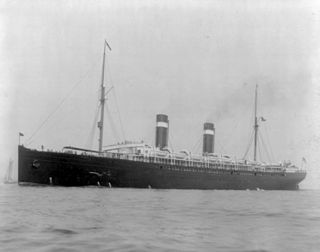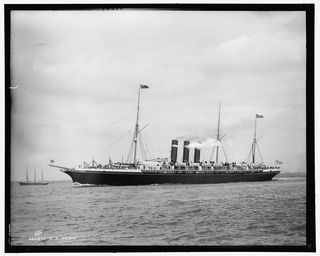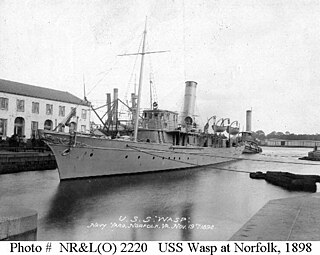
USS Iowa was a pre-dreadnought battleship built for the United States Navy in the mid-1890s. The ship was a marked improvement over the previous Indiana-class battleships, correcting many of the defects in the design of those vessels. Among the most important improvements were significantly better seaworthiness owing to her greater freeboard and a more efficient arrangement of the armament. Iowa was designed to operate on the high seas, which had been the impetus to increase the freeboard. She was armed with a battery of four 12-inch (305 mm) guns in two twin-gun turrets, supported by a secondary battery of eight 8-inch (203 mm) guns.

USS Wyoming (BB-32) was the lead ship of her class of dreadnought battleships and was the third ship of the United States Navy named Wyoming, although she was only the second named in honor of the 44th state. Wyoming was laid down at the William Cramp & Sons in Philadelphia in February 1910, was launched in May 1911, and was completed in September 1912. She was armed with a main battery of twelve 12-inch (305 mm) guns and capable of a top speed of 20.5 kn.

The first USS Dixie was a United States Navy auxiliary cruiser and later a destroyer tender. The Dixie was the first ship of the United States Navy to have this name.

SS St. Louis, was a transatlantic passenger liner built by the William Cramp & Sons Building & Engine Company, Philadelphia and was launched on 12 November 1894; sponsored by Mrs. Grover Cleveland, wife of the President of the United States; and entered merchant service in 1895, under United States registry for the International Navigation Co., of New York City with her maiden voyage between New York and Southampton, England. She was acquired by the United States Navy during the Spanish–American War and commissioned under the name USS St. Louis in 1898, and again during World War I under the name USS Louisville (ID-1644) from 1918 to 1919. After she reverted to her original name in 1919, she burned in 1920 while undergoing a refit. She was scrapped in 1924 in Genoa.

The Battle of Guantánamo Bay was fought from June 6 to June 10 in 1898, during the Spanish–American War, when American and Cuban forces seized the strategically and commercially important harbor of Guantánamo Bay, Cuba. Capturing the bay from the Spanish forces was instrumental in the following Battle of Santiago de Cuba and the subsequent invasion of Puerto Rico. Although overshadowed by the land and sea battles at Santiago, the establishment of the United States naval base at Guantánamo Bay and the rout of defending Spanish troops by American and Cuban forces was important in the final Spanish defeat.

The second USS Marblehead (C-11/PG-27) was a Montgomery-class unprotected cruiser in the United States Navy, authorized in the naval appropriations bill of September 7, 1888. Marblehead served in the Spanish–American War and World War I, and was the last ship of her class in service.

George Barnett was the 12th Commandant of the United States Marine Corps. He was a pioneer of amphibious warfare and the U.S. Marine Commandant during American involvement in World War I.

USS Goldsborough (DD-188/AVP-18/AVD-5/APD-32) was a Clemson-class destroyer in the United States Navy during World War II. She was the second Navy ship named for Rear Admiral Louis M. Goldsborough (1805–1877). Entering service in 1920, the ship had a brief active life before being placed in reserve in 1922. Goldsborough was reactivated for World War II and was used as an aircraft tender, destroyer and high speed transport in both Atlantic and Pacific theaters. Following the war, the ship was sold for scrapping in 1946.

USS Yankee was originally El Norte, a steamer launched 14 June 1892 and delivered 15 August 1892 at Newport News, Virginia, by the Newport News Shipbuilding & Drydock Co. for the Southern Pacific Railroad's Morgan Line. The ship was acquired by the United States Navy from the Southern Pacific Company on 6 April 1898. The ship was renamed and commissioned at New York on 14 April 1898, Commander Willard H. Brownson in command.

Major General Charles Heywood was the ninth Commandant of the Marine Corps. He served as an officer for over 45 years and was the first Marine to reach the rank of major general. During Heywood's term as Commandant, the size of the Corps more than tripled, from 2,175 Marines to 7,810 total.

City of Paris, was a British-built passenger liner of the Inman Line that held the Blue Riband as the fastest ship on the north Atlantic route from 1889 to 1891 and again from 1892 to 1893. A sister ship of the City of New York and a rival of the White Star Line Teutonic and Majestic, she proved to be the quickest of the pre-Campania twin-screw express liners. In 1893, she was renamed Paris and transferred to US registry when the Inman Line was merged into the American Line. She and her sister were paired with the new American built St Louis and St Paul to form one of the premier Atlantic services. Paris served the US Navy as the auxiliary cruiser USS Yale during the Spanish–American War and is remembered for slipping into the harbor at San Juan, Puerto Rico, under the Spanish guns of Morro Castle. After Paris returned to commercial service, she was seriously damaged in 1899 when she grounded on The Manacles off the British coast. Rebuilt and renamed Philadelphia, she sailed for the American Line until requisitioned again during World War I as the transport Harrisburg. After the war, she continued with the American Line until 1920 and was scrapped in 1923.

USS Porter was a torpedo boat, the first of her class, launched in 1896, served during the Spanish–American War, and struck in 1912. She was the first Navy ship named for Commodore David Porter, and his son, Admiral David Dixon Porter.

USS Topeka (PG-35) was a gunboat of the United States Navy.

USS Vulcan was an iron-hulled, schooner-rigged screw steamship acquired by the U.S. Navy for use as a repair ship during the Spanish–American War.

The second USS Suwannee and third USS Mayflower was a United States Lighthouse Board, and later United States Lighthouse Service, lighthouse tender transferred to the United States Navy in 1898 for service as an auxiliary cruiser during the Spanish–American War and from 1917 to 1919 for service as a patrol vessel during World War I. She also served the Lighthouse Board and in the Lighthouse Service as USLHT Mayflower from 1897 to 1898, from 1898 to 1917, and from 1919 to 1939, and in the United States Coast Guard as the first USCGC Mayflower (WAGL-236) in 1939 and from 1940 to 1943 and as USCGC Hydrangea (WAGL-236) from 1943 to 1945.

The seventh USS Wasp was the former yacht Columbia, purchased by the U.S. Navy and converted to an armed yacht serving from 1898 to 1919, with service in the Spanish–American War and World War I.

USS Outpost (AGR/YAGR-10) was a Guardian-class radar picket ship, converted from a Liberty Ship, acquired by the US Navy in 1956. She was reconfigured as a radar picket ship and assigned to radar picket duty in the North Atlantic Ocean as part of the Distant Early Warning Line.
USS Waban was a steamer in commission in the United States Navy from 1898 to 1919.

The second USS Osceola, later AT-47, was a United States Navy armed tug in commission in 1898 and in combat in the Spanish–American War, and from 1911 to 1922.

USS Wompatuck (YT-27) was an armed tug in commission in the United States Navy from 1898 to 1931. Early in her naval career, she saw combat in the Spanish–American War and the Philippine–American War. After she was decommissioned, she was selected for conversion into the fuel oil barge YO-64, but she was lost in the early days of World War II in the Pacific before the conversion could be completed.




















